Warning. This review contains spoilers for Rough Nights & Hard Days.
I concluded my review of WFRP4 by emphasising the importance of its being supported with good adventures. The first WFRP4 adventure has now arrived, so it is time to put that view to the test. Is Rough Nights & Hard Days a diamond in the rough, or is it a bit rough around the edges?
BACKGROUND
First, some history is in order. In 1987 Graeme Davis wrote a short WFRP1 scenario for White Dwarf that was set in an inn. He had several ideas for the plot, but unable to choose between them, decided to use all of them at once.
Such an approach had never been tried before in role-playing games, and Davis was uncertain whether it would work. But it did, and ‘A Rough Night at the Three Feathers’ became an instant classic.
The success of ‘A Rough Night’ led to a number of reprints. It also encouraged Davis to try the same style of adventure again, first in ‘Nastassia’s Wedding’ for WFRP1, then in the masked ball section of The Edge of Night for WFRP3.
Rough Nights & Hard Days takes the three adventures above, and combines them with two further adventures in the same style to create a short campaign.
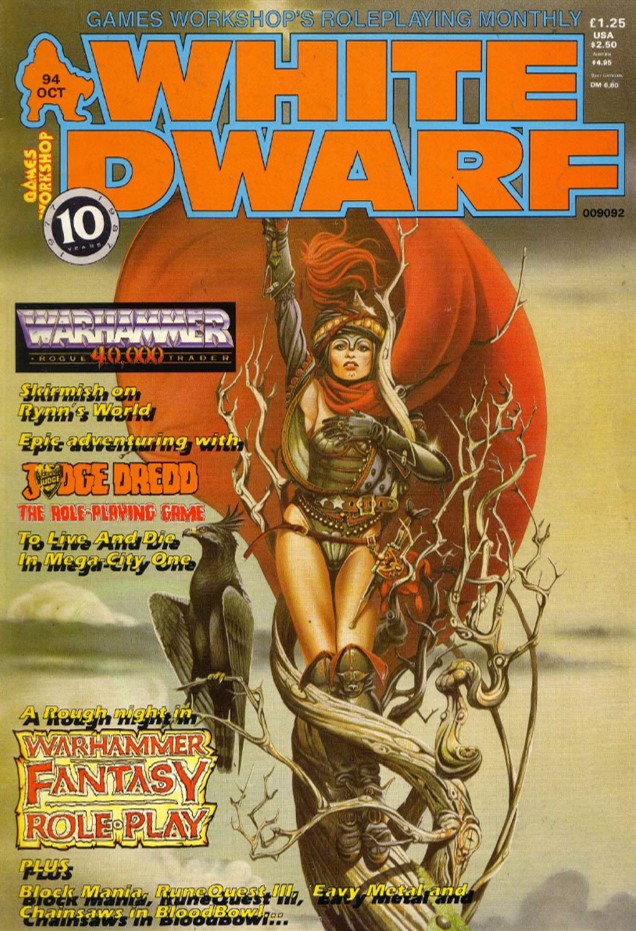
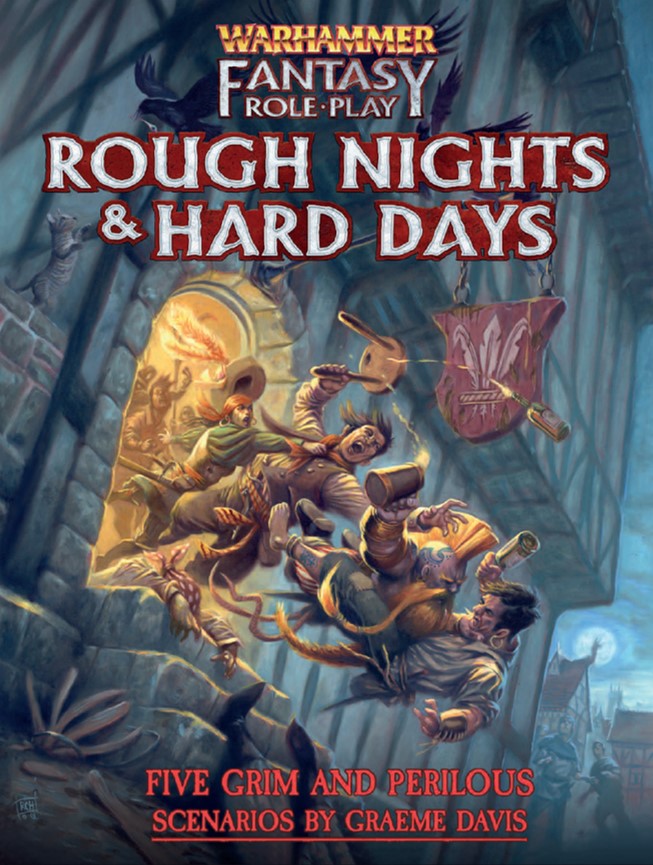
That was then … this is now
PRESENTATION
Rough Nights & Hard Days comprises 95 pages, 49 of which are the reprinted adventures, 32 the new adventures and 10 a pair of appendices covering gnome PCs and pub games. It uses the same graphical style as the WFRP4 rulebook, and looks every bit as good (though there are a handful of minor typographical errors).
HARD DRINKING AT THE INN
The first adventure, ‘A Rough Night of the Three Feathers’, is an almost verbatim reprint of the one that appeared in WD94. The unnamed halfling of the original has a slightly expanded role (which she reprises in ‘Lord of Ubersreik’), and three brief ideas for reusing the inn are provided, but otherwise the adventure narrative is essentially unchanged. This is no bad thing. The original was a classic for good reason, and there is no need to change such a successful formula.
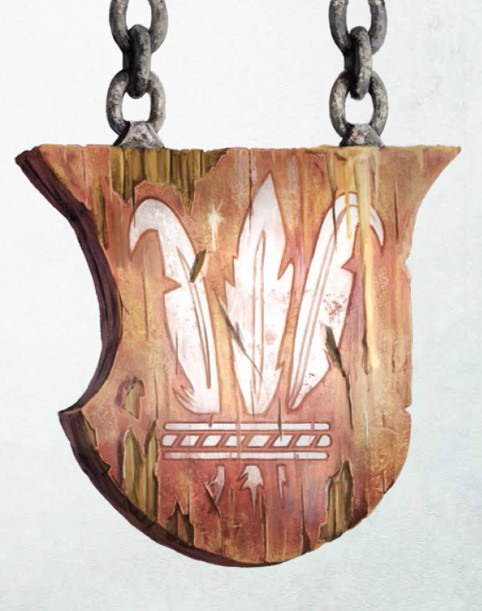
The new edition does, of course, include WFRP4 statistics. There are also fuller descriptions of the inn and NPCs, but in my view they serve only to highlight their redundancy; the adventure narrative tells the GM all he or she needs to know.
The adventure combines seven different storylines, which run concurrently in a single location on a single night. In terms of classical dramatic analysis, it preserves the unities of time and place, but violates the unity of action. It’s an immensely effective structure. Breaking the unity of action not only ensures that the narrative is packed with incident, but it also allows the different storylines to interact, often in unpredictable ways. In contrast, the unities of time and place bring the action into tight focus.
The seven plots mainly revolve around the visit to an inn of the Gravin Maria-Ulrike von Liebwitz of Ambosstein: the assassination of her judicial champion by the noble house of von Dammenblatz (ho, ho); the blackmail of her lawyer by a Chaos cult; her servant’s discovery of an illicit affair; and the cuckolded party’s attempt to get revenge. There are also plots concerning an attempt to smuggle a wanted man in a coffin; the bounty hunter on his tail; and a gnome pickpocket.
While the juggling of so many narratives might seem a challenging prospect for the GM, in my experience it is not. The adventure presents short summaries of each plot and then a precise chronology of events with cross references to the plot summaries. This makes it fairly straightforward for the GM to understand the action from both perspectives and run the scenario without problems.
ROUGH JUSTICE AT THE COURT HOUSE
The second adventure, which is inconsistently referred to as ‘A Hard Day at the Trials’ and just ‘A Day at the Trials’, continues the narrative from ‘A Rough Night’. Following the assassination of the Gravin’s judicial champion, one of the PCs has taken over his role and has to defend the Gravin in battle at the court house in Kemperbad.
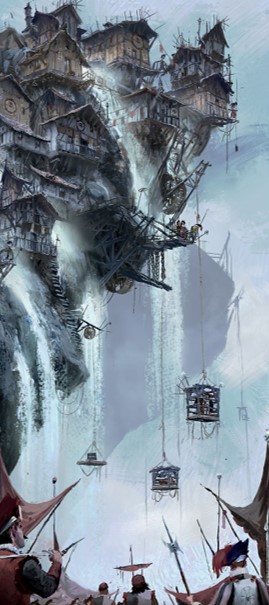
The structure of ‘A Hard Day’ replicates that of ‘A Rough Night’, with seven plots taking place at the court house in one day. Most of these are continuations of those in ‘A Rough Night’. In fact, they are almost replicas: von Dammenblatz agents are again trying to hobble the Gravin’s champion; her lawyer is still being harassed by the Chaos cult; the bounty hunter is after her reward; the gnome thief is back picking pockets. It is natural that there should be some development of these storylines, but the similarity creates a sense of déjà vu, especially as the adventure should follow soon after the events at the Three Feathers.
The feeling of familiarity is not greatly lessened by the new plots: a prison break out, whose only role is to create a (literal) big bang; a witch hunter encountering the ghost of an innocent victim; and the tiredest of WFRP tropes, demon-summoning cultists.
There is also less interaction among the plots and more repetition of events. Some elements are left a little sketchy. For example, the text does not clearly describe the impact on subsequent events of the Gravin’s lawyer dying in the first assassination attempt. In fairness, this would not be hard for the GM to fix, but the omission points to a little less polish than I would expect from a commercial product.
There is a nice conceit where interruptions repeatedly stop the judicial combat just after it starts, but overall this is in my view the weakest of the five adventures.
I personally would prefer to change things more for the second outing. Repeating both the structure and the plots is too much. Though it means departing from the formula, I would impose greater unity of action and try to make more of fewer plots. I would focus on the von Dammenblatz and break-out plots, expanding them and all but eliminating the rest. For example, the attacks on the Gravin’s lawyer would be removed or attributed to von Dammenblatz agents; the prison break would be the first interruption of the combat and subsequent interruptions would be the result of escapees’ actions, such as an escaped victim seeking vengeance on the witch hunter or a magistrate.
Another aspect I find a little disappointing is the handling of the finale. Should the PCs fail to defend the Gravin in combat, there is a deus ex machina that ensures the Gravin escapes on a technicality and everyone lives happily ever after. This ensures the campaign is not derailed, but at the expense of massively reducing the stakes. My preference would be to have the Gravin dragged away in chains, howling in fury, first dismissing the PCs for their incompetence, then suggesting they were in league the von Dammenblatzes. The PCs would have to leave town before they face the consequences, and only discover the Gravin’s ingenious legal escape later when they bump into her at the opera, and have an (awkward) chance to redeem themselves.
A HARD ACT TO FOLLOW
The third adventure, ‘A Night at the Opera’, concerns a night at the opera in Nuln to celebrate the Gravin’s (inevitable) judicial victory.
We have seven more plots, and again some familiar faces: House von Dammenblatz is back, seeking revenge; the Chaos cult is still pursuing the Gravin’s lawyer; the witch hunter is on the Gravin’s tail; and the gnome thief returns, but with bigger things on his mind. The campaign does not precisely repeat itself, but it certainly does rhyme.
Fortunately, the plots also introduce several new elements. Those with a sense of nostalgia will particularly appreciate two: a Nurgle cult and the Schatzenheimer, Valantina and Hydermans gangs are pursuing Albrecht Oldenhaller; and a playwright is seeking vengeance on none other than Detlef Sierck. Further spice is added by some gunnery student pranks and rivalry between the noble houses of Toppenheimer and von Liebwitz (which seems to have lost an “e” between editons).

This is a better scenario than ‘A Hard Day’. Although some of the plot elements recur, they do so in a more interesting manner (which makes the threads in ‘A Hard Day’ seem even staler in comparison). Also more time is likely to have elapsed since the visit to the Three Feathers, which makes repetition more tolerable.
I would probably tweak some parts. The gunnery student pranks are a little over the top for my tastes, and the gnome thief does not add very much. Depending on the circumstances, I might also modify the Oldenhaller plot. It mostly leaves the PCs as spectators, and and is of less interest if they have not played ‘The Oldenhaller Contract’. I would either give the players some agency in dealing with the gang assassins, or omit them altogether and just run with the Nurgle cult. This could then lead nicely into ‘The Oldenhaller Contract’.
The scenario also includes a good sprinkling of follow-up ideas, and it is easy to see how this adventure could form the starting point for a Nuln campaign in its own right.
A ROUGH CROWD AT A WEDDING
The fourth adventure is the second reprint: ‘Nastassia’s Wedding’. This, however, is not an exact replica of the original. Some aspects which are a little sketchy in the original have been expanded in the reprint. There are some good notes on handling the aftermath of the adventure (which was almost entirely ignored in the first version). The castle gets a much-needed redesign and a proper map. Some of the events are fleshed out a little more. They are all good additions, though they do not quite make the adventure complete. For example, the scenario adds a rooftop chase, but does not provide a map or description; the GM is expected to improvise.
There are also minor changes. The recurring gnome thief has been squeezed in. The Arabian ka spirit in WFRP1 has become a Nehekharan wraith in WFRP4. This is presumably because of changes to the Warhammer background, but it seems to me slightly less colourful. (As an aside, the WFRP1 spirit is based on an Egyptian ba spirit, not ka. Given Graeme Davis’ extensive mythological knowledge, I am confident he was aware of this. I suspect he felt ba was not a suitably menacing name for an undead spirit.)

The adventure concerns events at an aristocratic wedding at Castle Grauenberg. There are (surprise!) seven different plots: the bride plans to elope with her secret lover; the bride’s father intends to give the groom a valuable sword, unaware that it is cursed; the father of the bride has a secret son locked away in the castle; a gangster is pursuing unpaid gambling debts; three different groups are seeking to steal a famous pink diamond with a flaw in the shape of a cat (the “Rose Tiger”, of course); a cult of Slaanesh summons a horde of demons (sigh); and von Dammenblatz is back again.
The plots are varied and play off each other nicely. They also contain exotica like taggees from Ind. It is a very good scenario. My only complaint would be that the Rose Tiger plot is surely a missed opportunity to bring back a certain Bretonnian gnome detective….
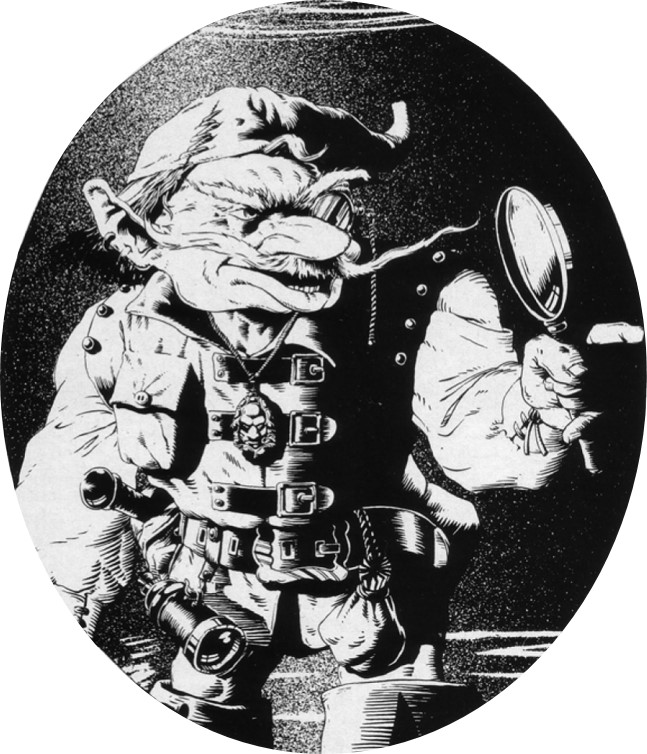
Eet eez I, Alphonse ‘Ercules de Gascoigne!
HARD LUCK AT THE BALL
The final adventure, ‘Lord of Ubersreik’ is another reprint. I have never read the original, so cannot make a detailed comparison. It takes the adventurers to Ubersreik and a masquerade ball where various noble families are competing for position. In addition to backstabbing aristocrats the plots this time include: skaven attempts to poison the guests; another illicit affair; a lecherous drunk; a mischievous wizard; the return of the witch hunter; and von Dammenblatz’s final revenge.
Although it shares the same presentation as the earlier scenarios, in this instance it seems to match the underlying structure of the adventure less well. The action mainly revolves around a single multifaceted plot concerning the rival noble families. This has been squeezed into two plot threads in the summary, but in reality there are more elements, which get glossed over. For example, the von Saponatheim’s secret heir returns after his escape in ‘Nastassia’s Wedding’, but this is not mentioned in the summary.
The machinations and antics of the noble houses make for some potentially great roleplaying, but running them poses some challenges. First, there are a large number of nobles involved, who are mostly referred to by their first names (some of which are shared). It makes it hard to track who belongs to which family.
Second, I expect the scenario works best if there are strong allegiances and hostilities between the PCs and some of the noble families. The presence of the von Saponatheims, Pfiefrauchers and von Leibwitzes of Ambosstein partly fulfils this need, but it is not in my opinion enough. It might be useful for the GM to add earlier episodes to develop relationships with other noble houses.
Third, the scenario frequently refers to noble houses gaining or losing influence or status. I suspect the original WFRP3 version had some sort of tracker for this, and I feel the reprint would benefit from something similar.
This brings me to the final problem. It is made clear that none of the noble houses will be able to secure what they want and that the whole ball is futile. It seems an anticlimactic resolution. It would perhaps be better to allow a victor to emerge, with potentially significant repercussions for the PCs and the campaign.
Despite the challenges, it is a good scenario. I would be inclined to make it the culmination of several run-ins with noble families, and perhaps give it a grander setting, such as one of Countess Emmanuelle von Liebwitz’s famous parties, but I expect it also works well as it is written.
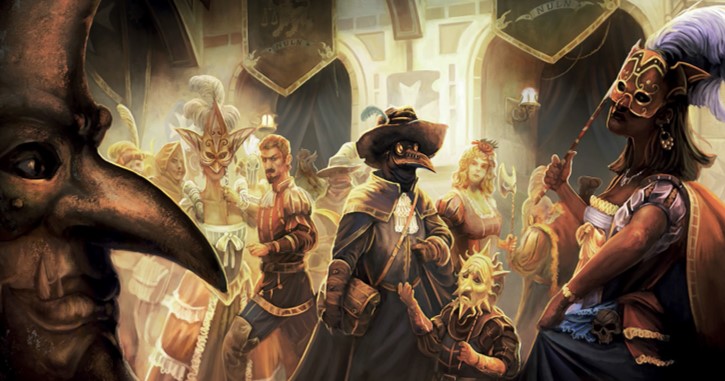
THERE’S NO RACE LIKE GNOMES
If the return of The Enemy Within, fimir, the Three Feathers, Albrecht Oldenhaller and Drachenfels left you with any doubts as to WFRP4‘s nostalgic bent, they should be dispelled by the biggest comeback of them all: gnomes.
Gnomes were offered as a PC race for WFRP1 in a article in WD86 (February 1987), and appeared briefly in a few adventures. But their last appearance (to my knowledge) was in Apocrypha Now (1995).
Their reappearance in Rough Nights & Hard Days is fleeting. There are only five pages dedicated to them, but they cover gnome character generation, a little on gnome culture and three gnome gods. The material mostly follows that of WFRP1, with the return of their settlement at Glimdwarrow and the god Ringil, but there are a few changes. There is greater cultural distance between gnomes and dwarfs. For example, gnomes are no longer associated with smiths but with pedlars. There are two new gods (Evawn, god of travel, trade and thievery, and Mabyn, goddess of shadows, revenge and magic). Gnomes are portrayed as rare and secretive, which neatly explains their infrequent appearances and long absence from the background.
I have to confess that nonhuman races do not generally provoke a great deal of enthusiasm from me. They can too easily fall back on Tolkienesque clichés. But WFRP4‘s gnomes have some personality. Moreover, it is encouraging to see how much latitude GW seems to be giving to Cubicle 7. It may bode well for the future.
Besides, think of the opportunities for puns….

CITIUS, ALTIUS, FORTIUS
Descriptions are given for fifteen pub games, including both background information and WFRP4 rules to allow characters to play them. Most are traditional games like darts, skittles, dominoes, cards and bowls, but given Old World twists. Snotball also makes an appearance, though it seems the Old World animal rights lobby has removed the snotlings and it is now Middenball. (There are, however, hints of illegal games still using live snotlings.)
The material obviously grew out of the arm-wrestling rules in the original ‘Rough Night’, but is not just filler. PCs spend enough time in inns that it is useful to have this sort of thing to fall back on.
OVERALL
I really like Rough Nights & Hard Days. It has some excellent adventures, and the background information is well done. But its overall value depends to some extent on your starting point. If you already own the three reprinted adventures, a significant part of its value is lost. However, two of those adventures are somewhat obscure, and there is a good chance that anyone who has accumulated all three is the sort of completist who will want the new edition anyway. If you’re not running WFRP4, you also miss out on a good portion of the supplement (WFRP4 statistics take up 25 pages of the total). But for WFRP4 GMs without the old releases, it is excellent.
It is not entirely without flaws. I have described those I perceive in the individual adventures above, but there is enough material that a good GM will be able to work it into whatever shape he or she prefers.
There are also in my view a couple of deficiencies in the campaign as a whole. First, although the von Liebwitz-von Dammenblatz feud is central to the entire campaign, its origins are described in the scantest fashion. Some more background would enrich the story. Why does von Dammenblatz blame the Gravin for his father’s death? Is it all a pretext? Or is the Gravin actually guilty? Is this a new feud or just the latest episode in one that has been running for centuries? Etc.
Second, the notes on combining the campaign with The Enemy Within are superficial. They do not address, for example, how the PCs drift in and out of the Gravin’s service. This matters in my opinion, as the campaign probably works best if combined with another, so that the similar structures of the adventures seem less repetitive.
But they are nitpicking points. Overall, I still think it’s great.
To buy Rough Nights & Hard Days from DriveThruRPG, click here.
To read my other WFRP4 reviews, see this link.
Artwork used without permission. No challenge intended to the rights holders. Links to DriveThruRPG are affiliate links. I receive a small payment for purchases made through them. This does not change the cost paid by the purchaser. The review copy of Rough Nights & Hard Days was purchased at my own expense. I have received no inducements in connection with this review.
How more exactly are those scenarii suggested to be implemented within TEW?
I presume that the timespan between Shadows over Bögenhafen and Power Behind the Throne might be somewhat completed as such:
“Shadows Over Bögenhafen”, in Enemy in Shadows.
“Messing About on the River”, in Death on the Reik.
“Weissbruck”, in Death on the Reik.
“Off To See the Wizard!”, in Death on the Reik.
The Ritual
“The Scheme of the Red Crown”, in Death on the Reik.
The Oldenhaller Contract
“A Rough Night at the Three Feathers”, in Rough Nights and Hard Days.
“Up the Reik”, in Death on the Reik.
“Kemperbad”, in Death on the Reik.
“A Hard Day at the Trials”, in Rough Nights and Hard Days.
“A Night at the Opera”, in Rough Nights and Hard Days.
“The Barren Hills”, in Death on the Reik.
“Castle Wittgenstein”, in Death on the Reik.
“Nastassia’s Wedding”, in Rough Nights and Hard Days.
“If looks Could Kill”, in Ubersreik adventures.
“Lord of Ubersreik”, in Rough Nights and Hard Days.
Carrion Up the Reik
The Grapes of Wrath
The Pie-Eyed Piper
Power Behind the Throne
…
LikeLike
Sorry for the slow reply.
Yes, Rough Nights & Hard Days seems to envisage something like that. The first two adventures might take place during Death on the Reik as the PCs travel from Grissenwald to Kemperbad. Presumably the PC champion is then released from the Gravin’s service and can continue The Enemy Within campaign. The GM then needs to create a break in The Enemy Within and find a way for the PCs to reconnect with the Gravin for the remaining adventures in Rough Nights & Hard Days.
LikeLike
A very thorough review – and one that does make it sound like a good product. More than the revised TEW, this was the adventure/campaign I was most interested in.
Your suggestions for other ways to end or run the scenarios all sound very helpful too. I suspect I would agree, were I ever likely to get to run them (sadly, I accept the chances of me ever playing again look pretty remote).
I’m glad that Nastassia’s Wedding has got something of an expansion; it always felt as though it deserved it and deserved to be better remembered, even if it perhaps could have done with an even greater one.
LikeLike
I have now bought and read Rough Nights. I can confirm this is a very good review – by which I mean, of course, I agree with it and it confirms my own personal biases. This would definitely work best if mixed in with other adventures, so that the Gravin becomes an occasional employer, patron, benefactor or adversary, depending on how events unfold.
The second adventure, Hard Day at the Trials, is somewhat disappointing. I’d almost be tempted to bin it entirely but the idea of making the distractions all relate to different escaped prisoners certainly has potential. The reasonably good chance that one of the assassination attempts on the Gravin’s lawyer might succeed would I think mainly cause an issue in the next adventure, Night at the Opera, as the further resolution of that plot thread there means that the witchhunter has potentially good cause to make risk a confrontation. I’m also uncertain why the cult would go from assassination to their eventual more subtle revenge. I would leave that element out too.
I am unconvinced that the addition of the gnome thief to every adventure works well either. It Is implausible that he turns up by chance everywhere but some players may like this. He could perhaps be kept for just a couple of outings (the Three Feathers, the wedding and the grand ball, perhaps) and still work well.
Your observations about the Oldenhaller plot line in Night at the Opera, I agree with entirely. The chances of the players picking up on what is happening with three assassins seems very slight, so we have a series of events there solely for the amusement of grognard GMs. Replacing them with one agent from the Schatszenheimers who is desperately trying to get to tell Oldenhaller that they would very appreciate it if he could arrange collection of the merchandise, and fending off Nurgle cultists, would work better and give a nice lead in to the Oldenhaller adventure.
The final adventure clearly requires some proper pre-figuring. If the characters know the participants and understand the politics involved, this could work very well. Without that, I imagine many might be fairly unengaged with many of the events. The role of the Skaven could do with some expansion too. If the players are aware that there is a possible threat they might be alert for it, otherwise they may not notice until half the nobility present have started sprouting tentacles.
Overall, good but perhaps just a little extra polish required.
LikeLiked by 1 person
I haven’t got the latest variant on this theme, It’s Your Funeral, yet, but I am hopeful it might actually work better than some of the scenarios in Rough Nights. It is a lot of work to generate thirty-five different plots and maintain the same quality, even if you are as talented as Graeme Davis. The input of different contributors might freshen the formula up.
LikeLike
I really enjoyed this review, very helpful. I linked over here on my blog/podcast last week so that others could enjoy it.
LikeLiked by 1 person
Thanks. I’m glad you liked it.
LikeLike
My biggest problem with the book: why would a PC willingly agree to take the place of the Champion, and more significantly, why would the rest of the PC’s agree to go with him/her? Feels way too railroady and, given that it’s a role forced onto a PC, likely to cause a little player resentment.
LikeLiked by 1 person
You make a good point. I think the original version relied on the following:
1 It was written with Death on the Reik in mind, and in that scenario the PCs have to travel to Kemperbad, anyway.
2 The PCs were offered a sizeable payment.
3 Accompanying the Gravin was presented as an alternative to being hanged for murder.
But you are right: ultimately the story relies on the Gravin exercising her power over the PCs to move the plot on.
LikeLike
Hey ho, just diving in to this adventure. The PC’s are offered a sizeable payment indeed (40GC), but do they really get it in the end? Weaving threads of stories I can do, but have PC’s in a sizeable town with big money is somewhat scary…
LikeLike
One thing the original Three Feathers benefitted from was that the plots were all of comparable stakes. Sure it’s unlikely that the players or PC’s would find the opportunistic thief as important as the murder plot, but if they lose a major possession, it’s not absurd that they might. But in a couple of the later scenarios, plots include the summoning of a horde of demons and skaven trying to poison everyone with warpstone – compared to that, the other plots are objectively relegated to distractions from what’s really going on – and in both cases, one of those distractions is the main connecting thread of the scenarios as a whole.
LikeLiked by 1 person
This “A Night at the Opera” scenario has nothing to do with the older scenario of the same name by Piers Brown, right? I’m trying to find the source for that one, but I’m stuck – it’s said to have been updated to 2nd edition by Alexander Bateman in 2009, which implies that it had originally been published for 1e, but I have no idea where and when. Can you help me out?
LikeLike
Yes, this was recently discussed on the Winds of Chaos forum. The new ‘Night at the Opera’ is an entirely different adventure from the old one that was first published in Adventures Unlimited 3 in 1995 and later converted for WFRP2 by Alexander Bateman. There are similarities: the title (alluding to a 1935 Marx Brothers movie and 1975 Queen album), the setting in a Nuln opera house and the presence of (Grand) Countess Emmanuelle von Lieb(e)witz. But the characters, plots and events are quite different.
LikeLike
Thank you for your extremely fast and helpful answer! I hadn’t heard of Adventures Unlimited before, but have been able to track it down.
LikeLike
Very late to this party. Excellent review and some insightful comments. The two adventures that definitely work are the “originals” Rough Night and Natassia’s Wedding (which has been improved, as you noted, by a a proper map). Lord of Ubersreik needs the context it had in the 3E adventure Edge of Night, where the PCs had to get the attention of one of the three claimants to be hired for the event. (The cards with pictures of the NPCs in the original were a godsend for running the social gathering.) I think you could use some of the less deadly encounters in “Lord” and Night at the Opera to run “Naughty Night in Nuln”, a soiree with social encounters, gambling, and some debauchery amongst Nuln’s nobles. Those performing well get an invite to the wedding. (I’d keep the exploding plant pot, but have agitators do the deed.) As you said, summoning demons at public events with powerful folk present needs to take a rest; it makes a sense in the likes of Night of Blood/Shadows over Bogenhafen because those suffering potential woe are “lowlife”. (The agitators do seem to have a point!)
I’d like to see 4E try to cover some fresh ground (like some of the intriguing projects you mention that never saw publication); I was interested in the Horned Rat, but there is more than a hint of a reheated meal.
LikeLiked by 1 person
Very, very late to this. Great reviews and insight. Next week (5/26/23), I’m going to be starting “Death on the Reik” with my group and I’m planning on incorporating this into the narrative with some tweaks:
The lawyer character is replaced entirely with a former PC who was retired following Oldenhaller Contract, because the player decided that his lawyer character wasn’t what he wanted to play. I wrote that character out by declaring that, being Attractive, of Noble Blood and pretty Charming, had managed to attract the attention of a very wealthy noblewoman. That woman is going to be the Gravin Maria-Ulrike herself. Said lawyer initially became an adventurer because he was failing University and faked a kidnapping with some friends (who are now retroactively turned into Ordo Ultima) to get away from an overbearing mother.
Dropping the gnome entirely. Not a lot of value added, I think.
Entering the Three Feathers thing while on the way to Kemperbad, and running the two adventures (tavern, then the Trial) mostly back-to-back, then moving onto Black Peaks. At Etelka’s cabin, going to tweak the findings so the PCs are pointed back to Nuln so the opera can transpire. Following the collapse of Castle Wittgenstein, I’m planning on having the boat damaged so they need repairs & the Boatman PC (former Smuggler) only trusts a guy in Nuln, which will then lead into the wedding. I’m very much toying with rewriting a bunch of that adventure to have the gravin also getting married (possibly to Udo von Bildhofen) at the same time with the PCs having the opportunity to ruin that help out their buddy’s romance with the gravin. Haven’t figured out if I’m going to go ahead with Lords of Ubersreik, though …
While doing the 1st part of TEW in Bogenhafen, the Knight PC (replaced the lawyer) desperately wanted to get into the tourney, so I used one of the ideas about having him pretend to be the son of Graf Wilhelm von Saponatheim – in the 4e adventure, it recommended using the Grand Duke’s son, but I created the son of Wilhelm before I picked up Rough Nights, so I’m going to retroactively rename that character to Manfred. Throughout the rest of their time in Bogenhafen, I played up tensions between the graf and grand duke over this as everyone KNEW that wasn’t the graf’s cowardly son unhorsing the grand duke’s man – yeah, the dice fricking hate me in combat. During the final part of the adventure, I then had Gideon, while wearing the Knight PC’s face, stab the graf’s son in front of the burning building. PCs had an angry mob charging toward them so they’ll only learn that Manfred died; in the wedding adventure, they may instead learn that he survived but is now psychotic due to corruption and the near death experience.
I probably will drop the Khorne cultists in the Trial adventure because yeah, it does feel a little deus ex machina there. Plus, I kind of like the idea of the Dammenblatz champion just being a regular dude who wants to get this stupid trial over with and might even start to respect the Knight PC (presuming he charges toward the ghost). Although I really do like your idea of it being escaped prisoners and not necessarily a ghost … although considering one of my players is running a witch hunter, I do sort of like the idea of reminding her to be absolutely sure of a “heretic’s” guilt before having them consigned to fire. I already changed Doctor Malthusius from the Schaffenfest to a secret witch hunter who trafficked in beastmen in order to drawn cultists like the Red Crown to him and the player really liked that idea…
LikeLike